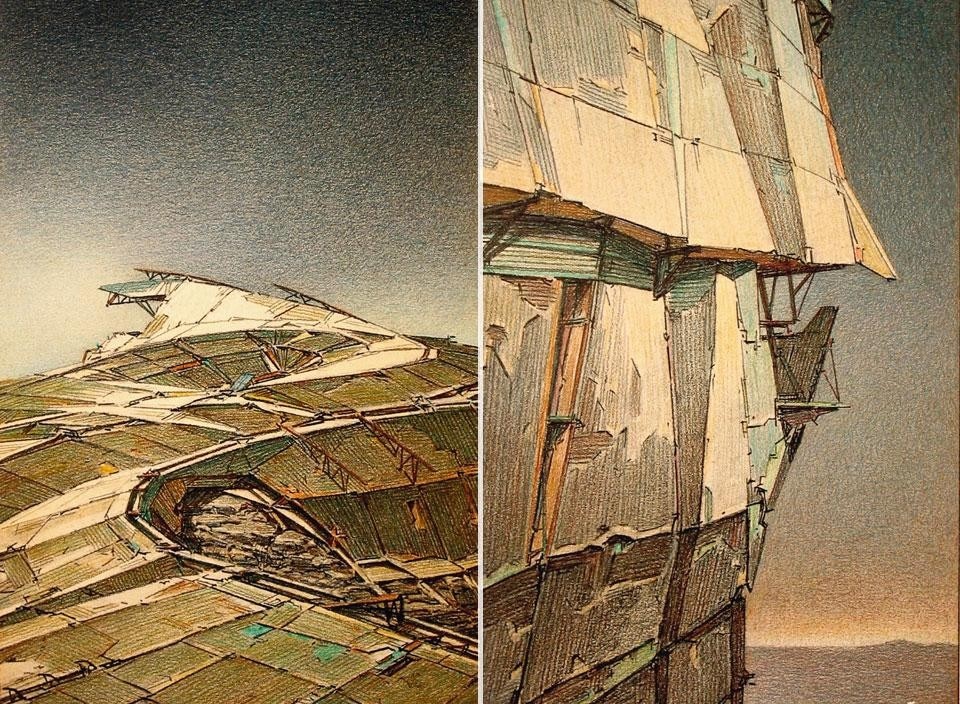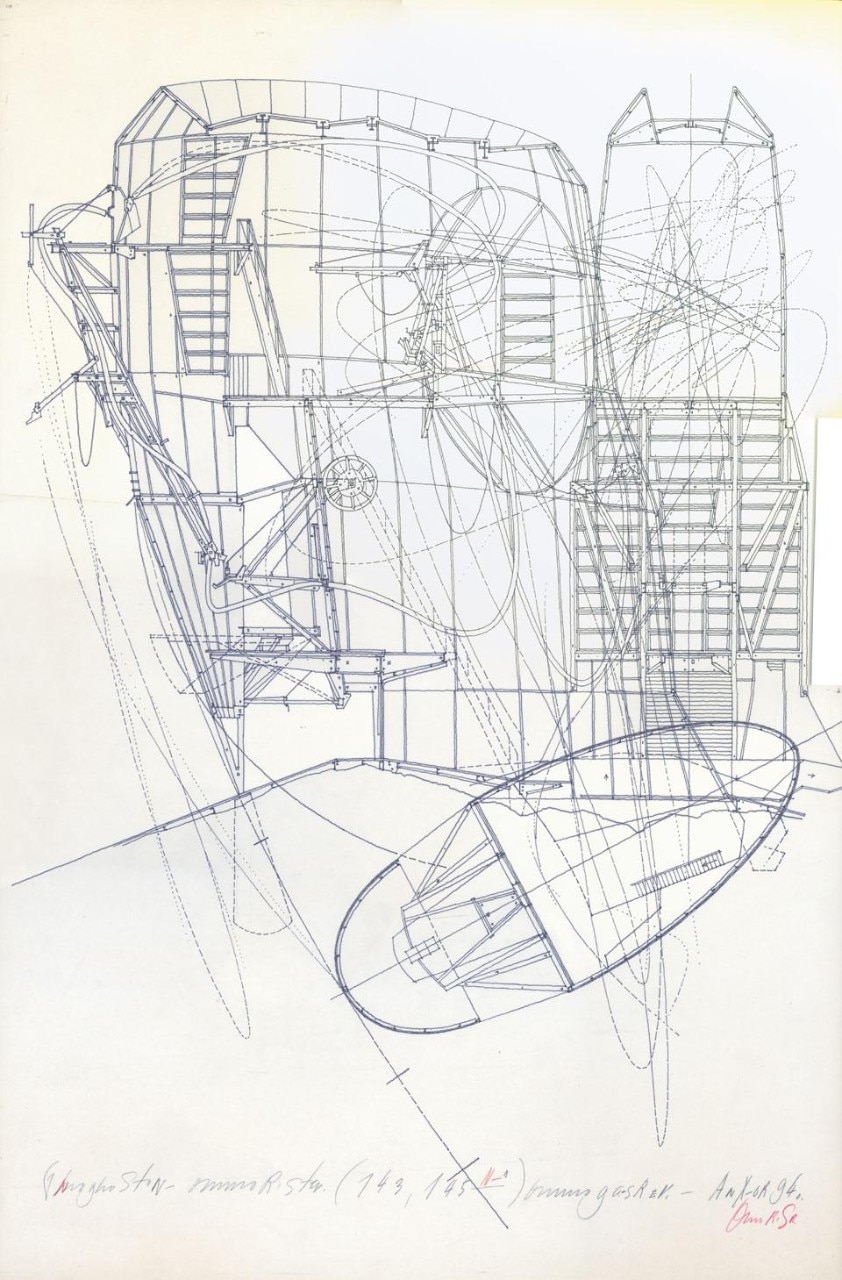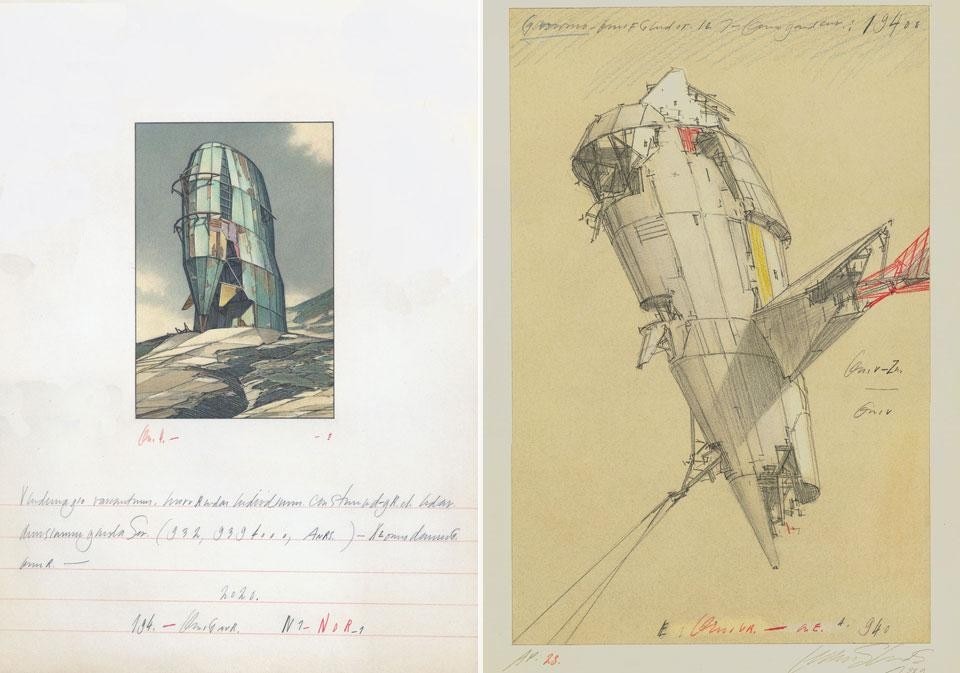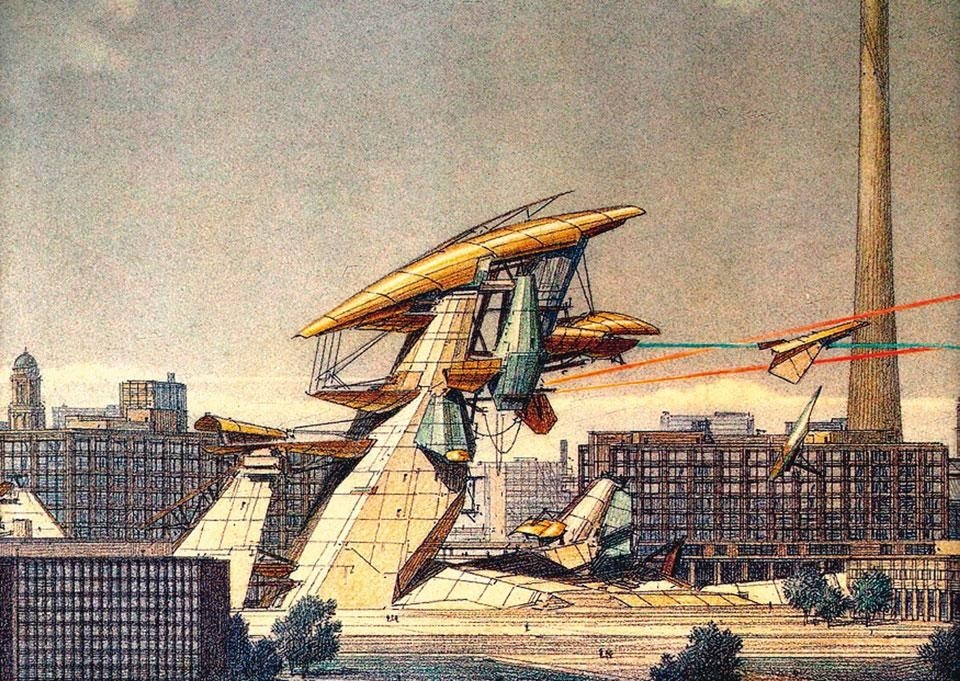Steven Holl
Lebbeus Woods made a project for Pamphlet Architecture #6 in 1979, titled Einstein Tomb. It was an amazing idea for a tomb travelling through space on a beam of light. Today, I imagine this invention is occupied by Lebbeus himself. He was launched into orbit on 30 October 2012 from Lower Manhattan via a storm. His own works were a starkly original, metaphysical revolt. He worked "out of time", away from the post-modern tendencies (1975- 1985), distinctly different from deconstructivist tendencies (1985-1995), and vastly different from computer-generated blob architecture (1995-2005). Lebbeus Woods wrote on War and Architecture with a sense of a state revolt. Likewise, he wrote about "resistance", but with sceptical reflection calling for "an independent idea of both Architecture and the world". Here are a few selections from his Resistance Checklist:
• Resist whatever seems inevitable
• Resist people who seem invincible
• Resist any idea that contains the word algorithm
• Resist the impulse to draw blob-like shapes
• Resist the desire to travel to Paris in the spring
• Resist the desire to move to Los Angeles, anytime
• Resist the idea that architecture is a building
• Resist the idea that architecture can save the world
• Resist the hope that you'll get that big job
• Resist getting jobs
• Resist taking the path of least resistance
• Resist the temptation to talk fast
• Resist anyone who asks you to design only the visible part
• Resist the idea that you need a client to make architecture
Stefano Boeri
I remember an emblematic story about Lebbeus Woods. When 12 Monkeys came out at the cinema, it was obvious that the sets had been completely inspired by his Neomechanical Tower (Upper) Chamber. He protested and asked why there was no mention of him. Most of all it was obvious that the cinema had involuntarily paid tribute to one of the world's most visionary city designers. Because this is what Lebbeus was: an architect of the imagination who, like few others in history (such as Cedric Price and Yona Friedman), knew how to construct powerful — because disturbing and revealing — scenographies in the world's collective mind.

To know Lebbeus was to know a real human. A person who did nothing more than live, which most of us do not. Essentially he lived for others, even as he perpetuated the myth of the singular figure. He worked to communicate, not to satisfy. He loved the fight, not out of righteousness, but out of principal. He loved pleasure, not out of hedonism, but as a shared experience. In his form of living, the world was a massive, inexhaustible cybernetic organism, and he described it through his drawings, his ideas, his writing, and in his love for humanity. He lived his work and his work lived him. He made you live deeper. While Lebbeus was always obsessed with the metrics of things, the way systems and phenomena could be measured, the one thing that could never be quantified was his own life. Lebbeus Woods lives on.
Zaha Hadid
It's a tremendous loss. Lebbeus was a very close friend and a great architect. His visionary work explored the fantastic potential and dynamism of space with radical proposals and powerful drawings that were extremely influential. His Light Pavilion in Chengdu will be testament that our profession has lost a great voice.
Christoph A. Kumpusch
In one of our last conversations, Lebbeus said, "Christoph, the biggest problem you can have in life is not having a problem." This was in response to us going through the latest photos Iwan Baan had just sent hours before from the Light Pavilion in Chengdu. Lebbeus explained that this space creates a problem, rather than a solution. He was excited and in the best of moods; excited about the images that were in front of us on a laptop screen, excited about imagining what people will do with the project as built. "This is completely unique. It hasn't been done before, has it?" We were toasting — heavily — and celebrating all by ourselves at 10:20am. Lebbeus set one glass aside, filled it, and announced, "That's for Steve, my first and best client ever." By around 11:00am we had an idea for another project. "It trumps it all! When can we go?" Lebbeus was fond of Kasper Gutman's line in The Maltese Falcon where, just before the police arrive, he says, "The best goodbyes are short. Adieu."
Geoff Manaugh
Lebbeus Woods was utterly unique and entirely irreplaceable, a full-scale terrestrial force for rethinking architecture's relationship not only with the earth and with gravity, but also with all of grounded philosophy, with any belief in stability, in calm. Lebbeus dove headlong into war, seismicity, urban collapse and even deep space, where perspective and horizon mean nothing, not to celebrate groundlessness but to help us all think through and discover new ways to belong, to build, to find a plane of reference worth trusting (if there can be such a thing). That is architecture at its very best and most urgent — and the relentless Lebbeus will be dearly and heroically missed.
Thom Mayne
Lebbeus. A man of huge integrity and an insatiable inquisitiveness to explore what he saw as the potentialities of an architecture — works of his mind untethered, unwilling to succumb to the contingent, the compromises inherent in our discipline. There was an equally powerful and balancing commitment to the political/cultural critique that was essential to his project as an architect, teacher and writer. He was, above all, interested in values: what is architecture for? His ethical understanding of our work gave him a moral authority which affected generations of architects. His search was for an authenticity of the present — to build the unbuildable, characterised by the ambiguities of time, the ephemerality of the durable, weight (gravity), physicality and an emotional content embracing a critical optimism with a sense of melancholy. Throughout our careers, we relied on one another for conversation, for deep understanding, for criticism of each other's work. When at a crossroads I would find him and he would generously and happily leave the aerie of his mind to enter fully into the work at hand. He would almost become me, in the sense that he so thoroughly understood and supported the intention and aspiration on the page. There was tremendous respect and love between us and I will miss him terribly. He had found his place and lived it free and undiminished until his death.

"I will forge in the smithy of my soul the uncreated conscience of my race. And I will try to express myself in some mode of life or art as freely as I can and as wholly as I can, using for my defence the only arms I allow myself to use: silence, exile and cunning." So said Joyce's Stephen Dedalus. I don't know that Joyce's goal is attainable. But it's the most moving advocacy I know for Dedalus's heroic aspiration. That aspiration also resonates in Lebbeus Woods's voice. That is the Woods archetype. Silence. Exile. Cunning.
Tomás Saraceno
Inside his drawings, inside our brain... he sculpted like nobody else... spaces we inhabit, nightmare dreams, out of this world... and as always... they were more real than reality...
Michael Sorkin
Lebbeus Woods was an authentic genius. His intelligence was radical and his work at once intense and effortless, filled with revolutionary joy. Such is the ineffability of genius: it works in the absence of will. Architecture poured from Leb's bottomless imagination, thought made material. But Leb was truly our hero not for the limpid miracle of his hand, but for what he chose to do with it. He was magnificently principled, firm and generous of conscience, dedicated to the cause of architecture as a social practice. He made art with a genuinely political interior, everywhere excavating for truth, never illustrating, constantly inventing. Whether Sarajevo ravaged, Berlin divided, San Francisco threatened by quakes, or Havana at risk from surging seas, Leb's architecture sited itself at the nexus of crisis and redress. And the results were never mere prophylaxis, never superficial, always an inquiry into the nature of necessity: Leb's work blew past the constriction of the merely possible, ever expanding the limits to happiness and to mind. In his wonderful Aerial Paris, Leb envisaged an acrobatic architecture unlimbered from gravity, freefloating and dancing in the sky. For so many years — in city designs of intricate mystery and gorgeous order, in building forms that sparked with potential between metaphysics and magic — Leb created a world only he could have conjured, a world that has forever shifted the dimensions of our own. Lebbeus Woods was the greatest architect of his time, and my own life would have been so much smaller without his example and his love.
Peter Noever
Merciless and passionately enthusiastic — that was my first thought when I was confronted with the sad news that I had lost a very special friend, a critical yet optimistic companion. The projects of Woods are positioned in locations and sites where contradictory realities break out into the open in the form of crises and violence. He viewed the task of the architect as being to design spaces and urban structures that react to the totality of human living conditions.
Hans Ulrich Obrist
With the demise of Lebbeus Woods, we have lost one of the great architectural thinkers. Over almost half a century, Woods offered us portals to other always unexpected dimensions. Woods, for whom architecture was an open gate to possibility, envisioned new and alternative forms of utopian thinking. Ernst Bloch defined utopia as "something that's missing". Similar to the late Édouard Glissant, Woods's utopia was quivering, trembling, because it transcended established systems of thought and subjected itself to the unknown. Glissant has inspired generations of architects with a deep philosophical commitment to architecture. Once he told me that it must be said from the start that trembling is not uncertainty, and it is not fear; that every utopia passes through this kind of thought. Utopia is a reality where one can meet with the other without losing oneself. In a text on utopia, Lebbeus asked, "Have we reached the end of utopia as well as the end of history? Let us listen to, and watch, the more ambitious and idealistic of the coming generation. Only they have the answer."
Lebbeus Woods was utterly unique and entirely irreplaceable, a full-scale terrestrial force for rethinking architecture's relationship not only with the earth and with gravity, but also with all of grounded philosophy, with any belief in stability, in calm

I write in mourning for the loss of a great teacher, a great and ethical artist, and a friend to the Cooper Union over decades. Lebbeus was also a close personal friend, someone with whom one could discuss architecture to the very limits of its being, and whose ethical compass and staunch resistance to the consumerist spectacle was a guidepost to us all. Much will be said in the ensuing months to speak of his profound interrogation of an architecture of resistance, of the loyalty and creativity he inspired in his students and friends, of the extraordinary corpus of drawings and three-dimensional installations, of the irreplaceable void that he leaves in the school and for us all. At Cooper we will celebrate his work with students; re-experience his exhibition in the Houghton Gallery following 9/11, "The Storm", and "The Fall", at the Fondation Cartier in Paris; and remember his love for us and the humility with which he taught and learned every day.
Mirko Zardini
I believe that Lebbeus Woods's most enduring legacy will stand in his great — and rare — ability to demonstrate that it is possible for resistance and optimism to coincide in architecture. And that architecture, just like drawings, "can be made anywhere there is light enough to see".
Kenneth Frampton
Lebbeus Woods was an enigma who lived his life in defiance of the society into which he had been thrown and by which he was besieged. It was not an easy passage for someone of his rough ethical sense. "What are poets for in a destitute time?" could have been applied more aptly to him than to many others. Hence the unremitting dystopia of his vision, compulsively laid onto paper in one distressed stroke of his talented mind's eye after another. With him it was Blade Runner all the way; the prophetic mise en scène of a world reduced to meaningless rubble, the crashed spaceships and tubular rail bridges of a doomed escape. Hephaestus mocked by the repelling hubris of his own poetic astral technology that even Lebbeus could be seduced by. Yet through all this he remained the passionate advocate of the creative spirit, and it is this that made him into an inspired teacher and a passionate and articulate nurturer of the tyro architect. He was an anarchic romantic to the core, which made him intolerant of unreconstructed erstwhile "New Deal" critics like myself. As he put to me during a review of student work at the Cooper Union, "You are preaching in the wrong church here." This was about it: a rebel without a cause versus a socialist without a country.


